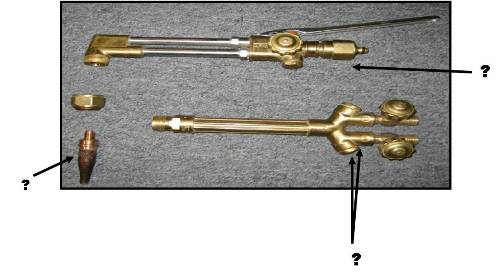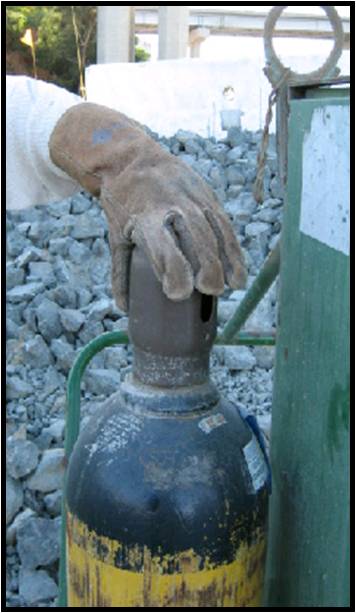Unit 3b - Oxy-acetylene Torches Quiz-2

Unit 3b (Oxy-Acetylene Torches)
- 1.
In regards to storage, cylinders which are full must be stored upright where they are protected from damage. However, empty cylinders may be stored horizontally and on the ground.
- A.
TRUE
- B.
FALSE
Correct Answer
B. FALSEExplanation
No cylinder is to be stored lying on the ground no matter if it is full or empty.
Cylinders can still contain pressure when empty. Also remember that the company who swaps out your empty cylinder for a full one often refills the empty cylinder for future use. A cylinder could be damaged if left on its side and cause an injury later down the road.Rate this question:
-
- 2.
Which parts of the torch are the arrows pointing to?
- A.
"cutting attachment, oxygen blast trigger, preheat oxygen"
- B.
"torch handle, cutting tip, preheat oxygen"
- C.
"cutting tip, flow arrestors, preheat oxygen"
- D.
"flow arrestors, control valves, cutting attachment"
Correct Answer
C. "cutting tip, flow arrestors, preheat oxygen"Explanation
The arrows in the image are pointing to the cutting tip, flow arrestors, and preheat oxygen. The cutting tip is the part of the torch that actually cuts through materials. The flow arrestors are safety devices that control the flow of gases in the torch. The preheat oxygen is used to heat up the materials being cut.Rate this question:
-
- 3.
When shutting down, the following should be done in what order? 1. Close cylinders2. Close acetylene valve on torch, followed by the oxygen3. Relieve line pressure valves4. Re-open Torch valves and allow for line to bleed off5. Cap cylinders, wrap up hoses, and store properly
- A.
"1, 2, 3, 4, 5"
- B.
"2, 1, 4, 3, 5"
- C.
"1, 2, 4, 3, 5"
- D.
"2, 1, 3, 4, 5"
Correct Answer
B. "2, 1, 4, 3, 5"Explanation
When shutting down, it is important to do so in the right order. 2, 1, 4, 3, 5Rate this question:
-
- 4.
A flashback arrestor is sometimes required.
- A.
TRUE
- B.
FALSE
Correct Answer
B. FALSEExplanation
Flashback arrestors are always required at regulator to prevent fire from traveling through to hose and into the cylinder.Rate this question:
-
- 5.
When opening an Acetylene bottle, open the valve slowly, no more than_____turns.
- A.
1
- B.
1 1/3
- C.
1 1/2
- D.
2
Correct Answer
C. 1 1/2Explanation
When opening an Acetylene bottle, it is important to open the valve slowly to avoid any sudden release of the gas. Opening the valve too quickly can cause a rapid expansion of the gas, which can lead to a dangerous situation. Therefore, it is recommended to open the valve no more than 1 1/2 turns to ensure a controlled and safe release of the Acetylene gas.Rate this question:
-
- 6.
Acetylene is a ___________ gas.
- A.
Stable
- B.
Unstable
Correct Answer
B. UnstableExplanation
Acetylene gas is very unstable.Rate this question:
-
- 7.
Typical setup is:- Tank/Cylinders- Regulators- Hoses- Torch- Fire Extinguiher
- A.
TRUE
- B.
FALSE
Correct Answer
A. TRUEExplanation
The given statement is true. In a typical setup for using a torch, the components include a tank or cylinders to store the fuel, regulators to control the flow of fuel, hoses to connect the regulators to the torch, the torch itself, and a fire extinguisher for safety purposes. Therefore, the statement accurately describes the typical setup for using a torch.Rate this question:
-
- 8.
Oxygen is a _____________ gas.
- A.
Combustible
- B.
Non-Combustible
- C.
Flammable
- D.
Explosive
Correct Answer
B. Non-CombustibleExplanation
Oxygen is an oxidizer and does not burn, but causes everything around it to burn including you!Rate this question:
-
- 9.
In regards to regulators, you should do all of the following EXCEPT:
- A.
Use for line checks
- B.
Use to control output pressure
- C.
Keep petrolium products away
- D.
Avoid cleaning
Correct Answer
D. Avoid cleaningExplanation
Regulators should not be avoided when it comes to cleaning. Cleaning is an important maintenance task for regulators to ensure their proper functioning and longevity. Regular cleaning helps remove dirt, debris, and other contaminants that may affect the performance of the regulator. It also prevents clogging and ensures smooth operation. Neglecting to clean regulators can lead to issues such as pressure fluctuations, leaks, and potential safety hazards. Therefore, all the given options are valid uses or precautions for regulators except avoiding cleaning.Rate this question:
-
Quiz Review Timeline +
Our quizzes are rigorously reviewed, monitored and continuously updated by our expert board to maintain accuracy, relevance, and timeliness.
-
Current Version
-
Mar 21, 2023Quiz Edited by
ProProfs Editorial Team -
Aug 13, 2008Quiz Created by
Kiewit
 Back to top
Back to top










